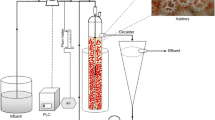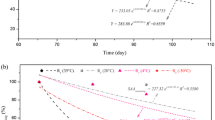Abstract
Sludge bio-drying in which sludge is dried by means of the heat generated by the aerobic degradation of its own organic substances has been widely used for sludge treatment. A better understanding of the evolution of dissolved organic matter (DOM) and its degradation drivers during sludge bio-drying could facilitate its control. Aeration is one of the key factors that affect sludge bio-drying performance. In this study, two aeration strategies (pile I—the optimized and pile II—the current) were established to investigate their impacts on the evolution of DOM and the microbial community in a full-scale sludge bio-drying plant. A higher pile temperature in pile I caused pile I to enter the DOM and microbiology stable stage approximately2 days earlier than pile II. The degradation of easily degradable components in the DOM primarily occurred in the thermophilic phase; after that degradation, the DOM components changed a little. Along with the evolution of the DOM, its main degradation driver, the microbial community, changed considerably. Phyla Firmicutes and Proteobacteria were dominant in the thermophilic stage, and genus Ureibacillus, which was the primary thermophilic bacteria, was closely associated with the degradation of the DOM. In the mesophilic stage, the microbial community changed significantly at first and subsequently stabilized, and the genus Parapedobacter, which belongs to Bacteriodetes, became dominant. This study elucidates the interplay between the DOM and microbial community during sludge bio-drying.





Similar content being viewed by others
References
Adani F, Baido D, Calcaterra E, Genevini P (2002) The influence of biomass temperature on biostabilization-biodrying of municipal solid waste. Bioresour Technol 83:173–179
Cai L, Chen T, Gao D, Zheng G, Liu H (2013) Influence of forced air volume on water evaporation during sewage sludge bio-drying. Water Res 47:4767–4773
Caporaso JG, Lauber CL, Walters WA, Berg-lyons D, Lozupone CA, Turnbaugh PJ, Fierer N, Knight R (2010) Global patterns of 16S rRNA diversity at a depth of millions of sequences per sample. Proc Natl Acad Sci U S A 108:1516–1522
Chen W, Westerhoff P, Leenheer JA, Booksh K (2003) Fluorescence excitation-emission matrix regional integration to quantify spectra for dissolved organic matter. Environ Sci Technol 37:5701–5710
DuBois M, Gilles KA, Hamilton JK, Rebers PA, Smith F (1956) Colorimetric method for determination of sugars and related substances. Anal Chem 28:350–356
Edgar RC, Haas BJ, Clemente JC, Quince C, Knight R (2011) UCHIME improves sensitivity and speed of chimera detection. Bioinformatics 27:2194–2200
Huiliñir C, Villegas M (2014) Biodrying of pulp and paper secondary sludge: kinetics of volatile solids biodegradation. Bioresour Technol 157:206–213
Ibarbalz FM, Figuerola ELM, Erijman L (2013) Industrial activated sludge exhibit unique bacterial community composition at high taxonomic ranks. Water Res 47:3854–3864
Jang HM, Cho HU, Park SK, Ha JH, Park JM (2014) Influence of thermophilic aerobic digestion as a sludge pre-treatment and solids retention time of mesophilic anaerobic digestion on the methane production, sludge digestion and microbial communities in a sequential digestion process. Water Res 48:1–14
Jewell WJ, Dondero NC, van Soest PJ, Cummings RT, Vegara WW, Linkenheil R (1984) High temperature stabilization and moisture removal from animal wastes for by-product recovery. Final report for the Cooperative State Research Service, US Department of Agriculture, USA, p 169
Kim S-J, Weon H-Y, Kim Y-S, Yoo S-H, Kim B-Y, Anandham R, Kwon S-W (2010) Parapedobacter luteus sp. nov. and Parapedobacter composti sp. nov., isolated from cotton waste compost. Int J Syst Evol Microbiol 60:1849–1853
Lechevalier MP, Lechevalier H (1970) Chemical composition as a criterion in the classification of aerobic actinomycetes. Int J Syst Bacteriol 20:435–443
Liang C, Das KC, McClendon RW (2003) The influence of temperature and moisture contents regimes on the aerobic microbial activity of a biosolids composting blend. Bioresour Technol 86:131–137
Liu S, Song F, Zhu N, Yuan H, Cheng J (2010) Chemical and microbial changes during autothermal thermophilic aerobic digestion (ATAD) of sewage sludge. Bioresour Technol 101:9438–9444
Magoč T, Salzberg SL (2011) FLASH: fast length adjustment of short reads to improve genome assemblies. Bioinformatics 27:2957–2963
Marhuenda-Egea FC, Martínez-Sabater E, Jordá J, Moral R, Bustamante MA, Paredes C, Pérez-Murcia MD (2007) Dissolved organic matter fractions formed during composting of winery and distillery residues: evaluation of the process by fluorescence excitation-emission matrix. Chemosphere 68:301–309
Michele P, Giuliana D, Carlo M, Sergio S, Fabrizio A (2015) Optimization of solid state anaerobic digestion of the OFMSW by digestate recirculation: a new approach. Waste Manag 35:111–118
Nakasaki K, Tran LTH, Idemoto Y, Abe M, Rollon AP (2009) Comparison of organic matter degradation and microbial community during thermophilic composting of two different types of anaerobic sludge. Bioresour Technol 100:676–682
Peterson GL (1977) A simplification of the protein assay method of Lowry et al. which is more generally applicable. Anal Biochem 83:346–356
Petrosino JF, Highlander S, Luna RA, Gibbs RA, Versalovic J (2009) Metagenomic pyrosequencing and microbial identification. Clin Chem 55:856–866
Roy G, Jasmin S, Stuart P (2006) Technical modelling of a batch biodrying reactor for pulp and paper mill sludge. CHISA 2006. 17th Int Congr Chem Process Eng 24:20
Ryckeboer J, Mergaert J, Vaes K, Klammer S (2003) A survey of bacteria and fungi occurring during composting and self-heating processes. Ann Microbiol 53:349–410
Said-Pullicino D, Gigliotti G (2007) Oxidative biodegradation of dissolved organic matter during composting. Chemosphere 68:1030–1040
Sharara M, Sadaka S, Costello T, VanDevender K (2012) Influence of aeration rate on the physio-chemical characteristics of biodried dairy manure - wheat straw mixture. Appl Eng Agric 28:407–415
Straathof AL, Comans RNJ (2015) Input materials and processing conditions control compost dissolved organic carbon quality. Bioresour Technol 179:619–623
Sugni, M, Calcaterra, E, Adani, F (2005) Biostabilization-biodrying of municipal solid waste by inverting air-flow. Bioresour Technol 96:1331–1337
Tkachuk VL, Krause DO, Knox NC, Hamm AC, Zvomuya F, Ominski KH, McAllister TA (2014) Targeted 16S rRNA high-throughput sequencing to characterize microbial communities during composting of livestock mortalities. J Appl Microbiol 116:1181–1194
Velis CA, Longhurst PJ, Drew GH, Smith R, Pollard SJT (2009) Biodrying for mechanical-biological treatment of wastes: a review of process science and engineering. Bioresour Technol 100:2747–2761
Villegas M, Huiliñir C (2014) Biodrying of sewage sludge: kinetics of volatile solids degradation under different initial moisture contents and air-flow rates. Bioresour Technol 174:33–41
Wang D, Xing L, Xie J, Chow CWK, Xu Z, Zhao Y, Drikas M (2010) Application of advanced characterization techniques to assess DOM treatability of micro-polluted and un-polluted drinking source waters in China. Chemosphere 81:39–45
Wang K, Li X, He C, Chen C-L, Bai J, Ren N, Wang J-Y (2014) Transformation of dissolved organic matters in swine, cow and chicken manures during composting. Bioresour Technol 168:222–228
Wei Y, Van Houten RT, Borger AR, Eikelboom DH, Fan Y (2003) Minimization of excess sludge production for biological wastewater treatment. Water Res 37:4453–4467
Winkler M-KH, Bennenbroek MH, Horstink FH, van Loosdrecht MCM, van de Pol G-J (2013) The biodrying concept: an innovative technology creating energy from sewage sludge. Bioresour Technol 147:124–129
Xia S, Duan L, Song Y, Li J, Piceno YM, Andersen GL, Alvarez-Cohen L, Moreno-Andrade I, Huang C-L, Hermanowicz SW (2010) Bacterial community structure in geographically distributed biological wastewater treatment reactors. Environ Sci Technol 44:7391–7396
Yadav TC, Khardenavis AA, Kapley A (2014) Shifts in microbial community in response to dissolved oxygen levels in activated sludge. Bioresour Technol 165:257–264
Yang B, Zhang L, Jahng D (2014) Importance of initial moisture content and bulking agent for biodrying sewage sludge. Dry Technol 32:135–144
Yassin AF, Spröer C, Siering C, Klenk H-P (2010) Actinomadura sputi sp. nov., isolated from the sputum of a patient with pulmonary infection. Int J Syst Evol Microbiol 60:149–153
Zhang D-Q, He P-J, Yu L-Z, Shao L-M (2009) Effect of inoculation time on the bio-drying performance of combined hydrolytic-aerobic process. Bioresour Technol 100:1087–1093
Zhang T, Shao M-F, Ye L (2012) 454 pyrosequencing reveals bacterial diversity of activated sludge from 14 sewage treatment plants. ISME J 6:1137–1147
Zhang J, Lü F, Shao L, He P (2014) The use of biochar-amended composting to improve the humification and degradation of sewage sludge. Bioresour Technol 1:1–7
Zhao L, Gu W-M, He P-J, Shao L-M (2010) Effect of air-flow rate and turning frequency on bio-drying of dewatered sludge. Water Res 44:6144–6152
Zhao J-K, Li X-M, Zhang M-J, Jin J, Jiang C-Y, Liu S-J (2013) Parapedobacter pyrenivorans sp. nov., isolated from a pyrene-degrading microbial enrichment, and emended description of the genus Parapedobacter. Int J Syst Evol Microbiol 63:3994–3999
Acknowledgments
This work is supported by the National Water Pollution Control and Management Technology Major Project of China (2012ZX07202-005) and the National Natural Science Foundation of China (21377151).
Conflict of interest
The authors declare no conflict of interest.
Author information
Authors and Affiliations
Corresponding author
Electronic supplementary material
Below is the link to the electronic supplementary material.
ESM 1
(PDF 606 kb)
Rights and permissions
About this article
Cite this article
Zhang, J., Cai, X., Qi, L. et al. Effects of aeration strategy on the evolution of dissolved organic matter (DOM) and microbial community structure during sludge bio-drying. Appl Microbiol Biotechnol 99, 7321–7331 (2015). https://doi.org/10.1007/s00253-015-6640-z
Received:
Revised:
Accepted:
Published:
Issue Date:
DOI: https://doi.org/10.1007/s00253-015-6640-z




